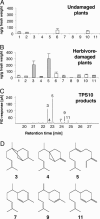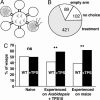The products of a single maize sesquiterpene synthase form a volatile defense signal that attracts natural enemies of maize herbivores
- PMID: 16418295
- PMCID: PMC1347987
- DOI: 10.1073/pnas.0508027103
The products of a single maize sesquiterpene synthase form a volatile defense signal that attracts natural enemies of maize herbivores
Abstract
Plants can defend themselves against herbivores by attracting natural enemies of the herbivores. The cues for attraction are often complex mixtures of herbivore-induced plant volatiles, making it difficult to demonstrate the role of specific compounds. After herbivory by lepidopteran larvae, maize releases a mixture of volatiles that is highly attractive to females of various parasitic wasp species. We identified the terpene synthase TPS10 that forms (E)-beta-farnesene, (E)-alpha-bergamotene, and other herbivory-induced sesquiterpene hydrocarbons from the substrate farnesyl diphosphate. The corresponding gene is expressed in response to herbivore attack and is regulated at the transcript level. Overexpression of tps10 in Arabidopsis thaliana resulted in plants emitting high quantities of TPS10 sesquiterpene products identical to those released by maize. Using these transgenic Arabidopsis plants as odor sources in olfactometer assays showed that females of the parasitoid Cotesia marginiventris learn to exploit the TPS10 sesquiterpenes to locate their lepidopteran hosts after prior exposure to these volatiles in association with hosts. This dissection of the herbivore-induced volatile blend demonstrates that a single gene such as tps10 can be sufficient to mediate the indirect defense of maize against herbivore attack.
Figures




References
-
- Dicke, M., van Beek, T. A., Posthumus, M. A., Ben Dom, N., Van Bockhoven, H. & De Groot, A. E. (1990) J. Chem. Ecol. 16, 381–396. - PubMed
-
- Meiners, T. & Hilker, M. (2000) J. Chem. Ecol. 26, 221–232.
-
- Kessler, A. & Baldwin, I. T. (2001) Science 291, 2141–2144. - PubMed
-
- Turlings, T. C. J. & Wäckers, F. L. (2004) in Advances in Insect Chemical Ecology, eds. Cardé, R. T. & Millar, J. (Cambridge Univ. Press, Cambridge, U.K.) pp. 21–75.
-
- Turlings, T. C. J., Tumlinson, J. H. & Lewis, W. J. (1990) Science 250, 1251–1253. - PubMed
Publication types
MeSH terms
Substances
Associated data
- Actions
LinkOut - more resources
Full Text Sources
Other Literature Sources
Molecular Biology Databases

